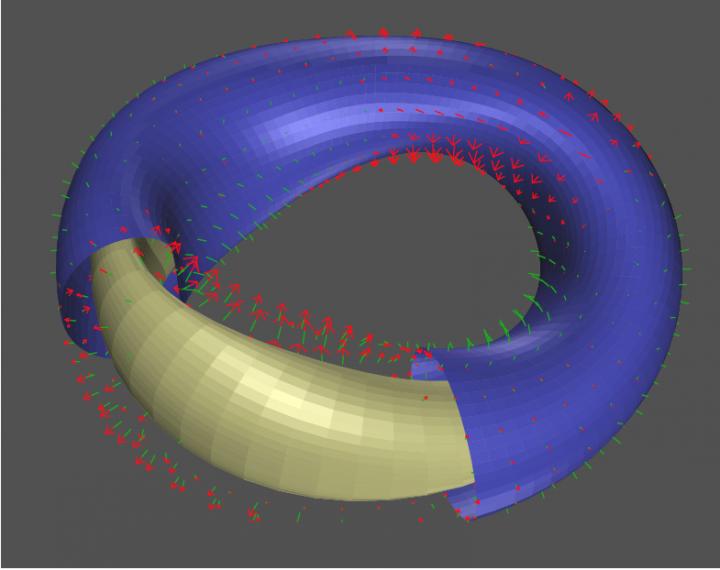
Credit: Coaxing Zhu
Permanent magnets akin to those used on refrigerators could speed the development of fusion energy – the same energy produced by the sun and stars.
In principle, such magnets can greatly simplify the design and production of twisty fusion facilities called stellarators, according to scientists at the U.S. Department of Energy’s (DOE) Princeton Plasma Physics Laboratory (PPPL) and the Max Planck Institute for Plasma Physics in Greifswald, Germany. PPPL founder Lyman Spitzer Jr. invented the stellarator in the early 1950s.
Most stellarators use a set of complex twisted coils that spiral like stripes on a candy cane to produce magnetic fields that shape and control the plasma that fuels fusion reactions. Refrigerator-like permanent magnets could produce the hard part of these essential fields, the researchers say, allowing simple, non-twisted coils to produce the remaining part in place of the complex coils.
Twisted coils most expensive
“The twisted coils are the most expensive and complicated part of the stellarator and have to be manufactured to very great precision in a very complicated form,” said physicist Per Helander, head of the Stellarator Theory Division at Max Planck and lead author of a paper describing the research (link is external) in Physical Review Letters (PRL). “We are trying to ease the requirement on the coils by using permanent magnets.”
Simplifying stellarators, which run without the risk of damaging disruptions that more widely used tokamak fusion devices face, can hold great appeal. “I am extremely excited about the use of permanent magnets to shape the plasma in stellarators,” said Steve Cowley, PPPL director and a coauthor of the paper. “It leads to much simpler engineering design.”
Fusion, the power that drives the sun and stars, combines light elements in the form of plasma — the hot, charged state of matter composed of free electrons and atomic nuclei — that generates massive amounts of energy. Scientists around the world are using tokamaks, stellarators, and other facilities in the effort to create and control fusion on Earth for a virtually inexhaustible supply of safe and clean power to generate electricity.
The novel idea for permanent magnets is an offshoot of a science fair project that Jonathan Zarnstorff, the son of PPPL Chief Scientist Michael Zarnstorff, a coauthor of the paper, put together in junior high school. Jonathan wanted to build a rail gun, a device that usually uses high-voltage current to generate a magnetic field that can fire a projectile. But the high-voltage current would be dangerous to use in a classroom.
Father and son solution
The solution that father and son arrived at was to use neodymium, or rare earth, permanent magnets to safely produce the magnetic field. Rare earth magnets have surprising and useful properties. They generate quite powerful fields for the magnets’ small size, and these are “hard” fields that are almost unaffected by other fields nearby. These magnets could thus provide what physicists call the “poloidal” part of a spiraling stellarator field, while simple round coils could provide the “toroidal” part that makes up the rest of the field. “I’d thought about that over the years but had no time to develop the idea,” Zarnstorff said. The notion finally came to fruition during discussions with Cowley and physicist Cary Forest of the University of Wisconsin-Madison.
Permanent magnets are always “on” in sharp contrast to the standard electromagnetic coils that stellarators and tokamaks use. Such coils create magnetic fields when an electric current runs through them — current that requires power supplies that permanent magnets do not need. Other advantages of the use of permanent magnets to simplify stellarator coils include:
- Lower cost than hand-crafted electromagnets;
- Creation of ample space between the simplified coils to facilitate maintenance;
- Ability to reposition the magnets to create a variety of shapes for the magnetic fields;
- Reduced engineering and manufacturing risks.
Permanent magnets have disadvantages, too. “You can’t turn them off,” Helander said, which means they can pull in anything they can attract within range. They also produce limited maximum field strength, he said. Nonetheless, such magnets “can be great for creating experiments on the way to a reactor,” he added, “and stronger permanent magnets may become available.”
New set of tools
For Zarnstorff, permanent magnets are “a strategy and a new set of tools, and we have to figure out how to use them.” He now plans several uses. First will come construction of a table-top stellarator with permanent magnets installed. Further ahead he hopes PPPL could produce the world’s first simple optimized stellarator, one designed to meet specific performance goals. That facility could be upgraded to increase its field strength, in preparation for continued development of the simplified machine. Eventually, a stellarator including permanent magnets might produce energy to generate electricity for all humankind.
###
Coauthors of the PRL paper include physicist Michael Drevlak of the Max Planck Stellarator Theory Division, who carried out the numerical optimization. Support for this work comes from the DOE Office of Science (FES), the Simons Foundation and the Max Planck Society.
PPPL, on Princeton University’s Forrestal Campus in Plainsboro, N.J., is devoted to creating new knowledge about the physics of plasmas — ultra-hot, charged gases — and to developing practical solutions for the creation of fusion energy. The Laboratory is managed by the University for the U.S. Department of Energy’s Office of Science, which is the single largest supporter of basic research in the physical sciences in the United States and is working to address some of the most pressing challenges of our time. For more information, visit energy.gov/science (link is external).
Media Contact
John Greenwald
[email protected]
609-243-2672
Original Source
https:/
Related Journal Article
http://dx.




